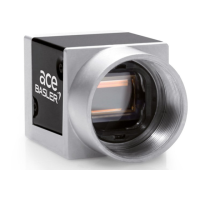Standard Features AW00097603000
242 Basler aviator GigE
10.14 Event Reporting
Event reporting is available on the camera. With event reporting, the camera can generate an
"event" and transmit a related event message to the PC whenever a specific situation has occurred.
The camera can generate and transmit events for the following types of situations:
An acquisition start trigger has occured (AcquisitionStartEvent).
Overtriggering of the acquisition start trigger has occurred
(AcquisitionStartOvertriggerEventData).
This happens if the camera receives an acquisition start trigger signal when it is not in a "waiting
for acquisition start" acquisition status.
A frame start trigger has occured (FrameStartEvent).
Overtriggering of the frame start trigger has occurred (FrameStartOvertriggerEventData).
This happens if the camera receives a frame start trigger signal when it is not in a "waiting for
frame start trigger" acquisition status.
The end of an exposure has occurred (ExposureEndEventData).
An event overrun has occurred (EventOverrunEventData).
This situation is explained later in this section.
An Example of Event Reporting
An example related to the Frame Start Overtrigger event illustrates how event reporting works. The
example assumes that your system is set for event reporting (see below) and that the camera has
received a frame start trigger when the camera is not in a "waiting for frame start trigger" acquisition
status. In this case:
1. A Frame Start Overtrigger event is created. The event contains the event in the strict sense
plus supplementary information:
An Event Type Identifier. In this case, the identifier would show that a frame start overtrigger
type event has occurred.
A Stream Channel Identifier. Currently this identifier is always 0.
A Timestamp. This is a timestamp indicating when the event occurred. (The time stamp
timer starts running at power off/on or at camera reset. The unit for the timer is "ticks" where
one tick = 8 ns. The timestamp is a 64 bit value.)
2. The event is placed in an internal queue in the camera.
3. As soon as network transmission time is available, an event message will be sent to the PC. If
only one event is in the queue, the message will contain the single event. If more than one
event is in the queue, the message will contain multiple events.
a. After the camera sends an event message, it waits for an acknowledgement. If no
acknowledgement is received within a specified timeout, the camera will resend the event
message. If an acknowledgement is still not received, the timeout and resend mechanism
will repeat until a specified maximum number of retries is reached. If the maximum number
of retries is reached and no acknowledge has been received, the message will be dropped.

